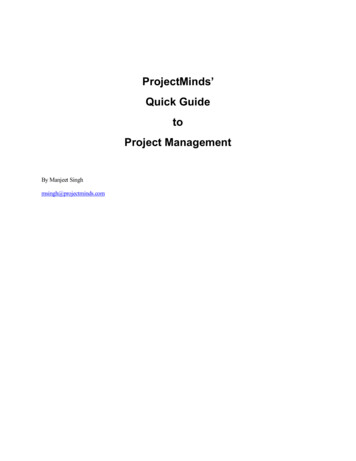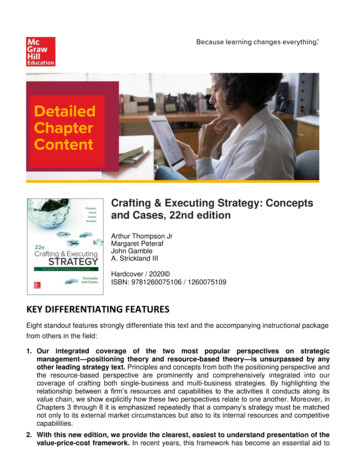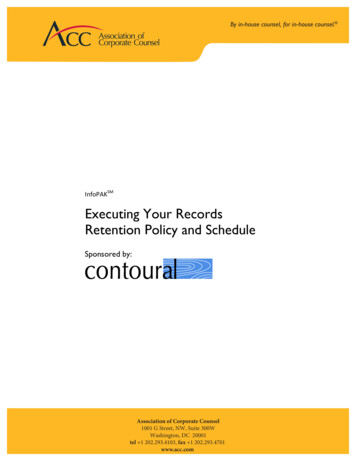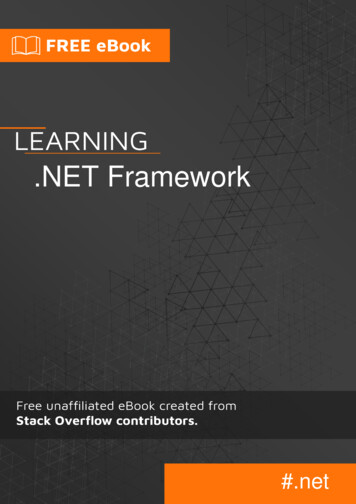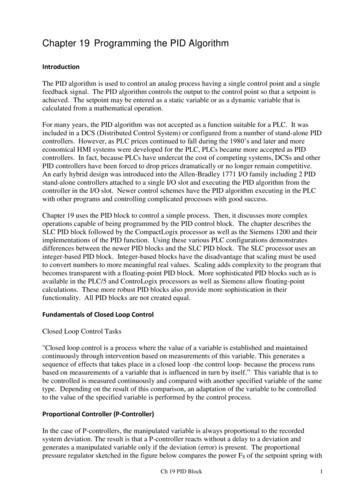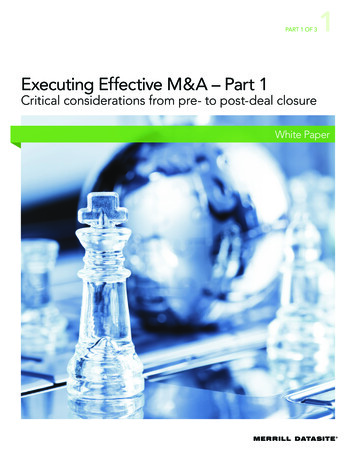
Transcription
PART 1 OF 31Executing Effective M&A – Part 1Critical considerations from pre- to post-deal closureWhite Paper
Executing Effective M&A – Part 1Table of Contents3 Executive Summary3 What is the right time for M&A?4 P reparing for success: Going to market andpreparing for due diligence5 H ow a virtual data room (VDR) enhancespre-deal preparation6 Conclusion
Executing Effective M&A – Part 1Executive SummaryIndustry experts in the M&A world sometimes refer to “theart of the deal.” It’s a phrase that encompasses the hard-tocharacterize actions that separate a successful venture fromone that’s doomed to failure, and it includes the experience,insight and knowledge displayed by the deal team in orderto ensure that a transaction ultimately creates the value thatwas intended.But, bend this metaphor into a slightly different shape andyou see that the “art” of a deal might only be a rigorousprocess, impeccably implemented.Imagine an M&A transaction is an actual piece of art,perhaps an oil painting by a master craftsman. The paintingprocess is broken down into a series of discrete steps beforethe masterpiece is achieved. The artist first must select acompelling subject, assemble the right paints, solventsand brushes, create and refine the initial sketches, and thencontinually rework the final image until the piece is finishedand its worth can be assessed in the marketplace.Similarly with M&A, each step in the process—from longbefore the deal begins until after it’s concluded—mustoccur with the proper subject, in the proper place, at theproper time, using the proper tools.Companies must painstakingly select the correct potentialtarget from among all the possibilities available to them;they must assemble the people to pursue the project, theymust conduct rigorous due diligence to fully understand thedeal, and once it’s done and the two new entities have beenintegrated, only then will management understand how themarket values their creation.With M&A, each step in the process—from long before the deal beginsuntil after it’s concluded—must occurwith the proper subject, in the properplace, at the proper time, using theproper tools.Both acquirers and sellers can benefit from examining theirdeal-making in light of this progression from beginning tomiddle to end. Following each stage methodically, as well asindustry best practices, can ensure that a deal is ultimatelysuccessful on all levels.We will start by examining how the M&A process canbe positioned for success even before the deal begins.(In Parts 2 and 3 of this series, we will look at best practicesduring deal due diligence, and also best practices for postmerger integration.)3
Executing Effective M&A – Part 1What time is the right time for M&A?M&A activity occurs whenever a company or group decidesto pursue changes that will result in a greater monetary valuebeing created than previously existed. Today, however, anumber of factors are combining to make the M&A processmore fractured, more complicated and lengthier thanever before as would-be buyers exercise extreme levels ofcaution for fear of making a poor buying decision duringturbulent times.Even during periods of uncertainty, however, companieswho want to grow still seek new product lines, new marketsand new geographic inroads. Organizations that wish to sellan asset want to realize the value they’ve achieved with thatproduct or they want to move in a new direction when thatasset is no longer necessary to the strategic corporate direction.In either case, both buyers and sellers could benefittremendously by positioning themselves for M&A effortslong before they sit down with a prospective partner. In fact,preparation for M&A should begin as much as 18 months priorto an actual deal, particularly in light of today’s market wherebuyers are weary of economic turmoil, political uncertainty andincreasingly litigious and regulated conditions.In some sophisticated companies with extensive experiencein M&A, such as private equity (PE) firms who manage alarge number of portfolio companies, internal companydocumentation may be assembled and prepared a year ormore prior to a potential sale.The reason?PE management know exactly what type of documentationand information potential acquirers will be looking for andthe format in which they will be most easily able to reviewit. Starting preparations early allows them to precisely tailorthat information to match the requirements of due diligence.In addition, by beginning to prepare and collect all M&Ainformation well in advance of a sale, everyone on the PEdeal team has time to carefully examine and digest thatinformation. They can take the time to identify potentialgaps or areas where more documentation is needed. Theycan do a “dry run” due diligence on their own data, testingthat their information systems and financial data are bothsolid and that their internal processes stand up to scrutiny.They can also anticipate the types of red flags that apurchaser might find alarming and then work to reducethose issues and ensure full disclosure in order to increasea buyer’s confidence levels. These sophisticated playersin the M&A world understand that a good process thatcontributes to faster, easier due diligence results in a betterM&A experience for everyone involved.Unlike other companies who have little to no experience withM&A, PE firms understand this before-deal preparation willeventually allow them to sell their portfolio companies to theright buyer, at the right price, in an expedited fashion.Preparing for success: Going to market and preparingfor due diligence?It’s a truth that shows up repeatedly throughout theM&A world: Deals that drag on and on often have anunsatisfactory outcome. A key reason that deals get boggeddown in due diligence is that often a company has notproperly prepared for the process.Due diligence processes that tend to falter are ones wherethe target company really didn’t understand what types—andhow much—information a thorough due diligence reviewwould demand. In that case, would-be purchasers mustcontinually request more and more information to completetheir diligence, which both slows down the deal and gives theimpression that the target company is lax and unprofessional.Preparation for M&A should beginas much as 18 months prior to anactual deal, particularly in light oftoday’s market where buyers areweary of economic turmoil, politicaluncertainty and increasingly litigiousand regulated conditions.In an unprepared company, documents have to either begathered ad hoc, or in worst-case scenarios, even created adhoc because they don’t exist in a usable format. That putsincredible strain on internal resources within the company,and hurrying to supply documents in response to specificrequests can lead to mistakes and other errors that willpotentially kill a deal.4
Executing Effective M&A – Part 1From a seller’s perspective, preparing for due diligenceinvolves assessing how an asset can be best packaged forsale. Especially in the type of buyer’s market that seems toexist now throughout the world, company managementmust decide early on how their asset might best berestructured, fine-tuned and ultimately financed.By starting the process early, in advance of actualnegotiations, the owners of an asset have the opportunityto present it in the best light. They can proactively addressany possible red flags that might trip a potential buyer, suchas regulatory, compliance or even political concerns forthe market in which they operate. This is particularly truefor companies that operate in certain emerging marketswhere the potential for corruption has been well reported,or in markets where increasing government oversight andregulation of issues, such as bribery, are on the rise.In addition, the faster an asset can be prepared for duediligence, the more ability a seller has to quickly react tofluctuations in the market. If a would-be seller maintains astate of asset-readiness by beginning document collectionwell before an expected deal, it becomes possible to quicklypull the trigger when market windows open.By making it exceptionally easy forpotential partners to review a deal,the potential buying audience for anasset is greatly expanded.Pre-deal preparation is also important for prospectiveacquirers today.For companies considering an acquisition, it’s criticalfor those involved to painstakingly identify and thencommunicate what they want to accomplish with anacquisition: Is it to extend the corporate footprint, to bolt-onan opportunity, to gain a geographic foothold in a certainregion or even to take out a competitor?Aligning the due diligence team with the corporate goalsfrom the outset is essential. Taking the time internally tofocus the acquisition team and key internal contacts on themerits of an acquisition ultimately lays the groundwork for agratifying deal conclusion.How a virtual data room (VDR) enhancespre-deal preparationA good document process and a good system that fostersthorough reporting on critical subjects, such as financials,legal and regulatory compliance efforts, anti-briberyprovisions, intellectual property concerns and humanresources issues will go a long way to actually executinga deal. As such, a virtual data room (VDR) can be thecritical tool that allows dealmakers to present all relevantinformation in a secure, centralized, Internet-accessible andeasy-to-use format.Another benefit of employing a VDR before you goto market is that it easily allows you to coordinate ageographically dispersed team without expensive andtime-consuming travel. A VDR greatly simplifiescoordinating pre-deal activities with expert advisors,wherever they are located, including bankers and legal/accounting/HR experts. Everyone can gather and postinformation to a single, secure platform, and then use thatplatform for all pre-deal reviews.By using VDR technology to benefit the deal team, worriesover emails that could potentially be leaked, or the problemof attachments that are too large to transmit easily areremoved. And, because the VDR serves as a centralrepository, it’s much easier to keep multiple people fromduplicating effort. A VDR keeps everyone focused insideone homogeneous platform to accomplish the documentcollection. It expedites information gathering by allowingfor collection and verification of exactly what’s needed,including the right version of any particular document.Using a top-line VDR also means that potential partnersfrom anywhere around the world can easily log in to theVDR to conduct early, “first look” due diligence. If a VDRwith industry-leading security features is employed,dealmakers can remain in complete control of who seeswhat information by virtue of the ability to grant varyingrights to different users. There are no limits in terms ofpotential targets or potential acquirers. A company inChina could sell itself to a company in Ohio, and vice versa.A potential acquirer can log in to the VDR from their deskand examine a potential acquisition anywhere in the world.This is clearly another benefit to employing a VDR: bymaking it exceptionally easy for potential partners toreview a deal, the potential buying audience for an assetis greatly expanded.5
Executing Effective M&A – Part 1In addition, by using the specialized tools built into thehighest-quality VDRs, once potential partners are invited toreview the deal, an effective audit trail is established, alongwith excellent insight into a potential partner’s motivations.The VDR “owner” can see exactly what information differentgroups are viewing, down to the exact amount of time theyhave spent on a particular page. This provides critical insightinto what a buyer might have concerns about, and allowstime for a proactive response.From the buyers’ standpoint, using a VDR as a due diligencevehicle means they will see a well-organized, searchablerepository of documents, and provides a favorableimpression of the asset, and the company selling it.Finally, if the correct VDR from a 3rd party vendor isselected, advantage can be gained from their extensiveindustry expertise, including pre-built indexes designedspecifically to help post the right types of informationfor more than 250 specific industries, such as mining ortechnology or pharmaceutical sales, or for specific dealtypes, such as distressed asset sales or bankruptcy actions.Selecting the right VDR partner can also provide access totheir expert consultants who can help design a best-practiceworkflow among team members to enable the end goal tobe achieved more quickly.ConclusionIn the world of mergers and acquisitions, executing a smartlyconceived, well-timed plan is everything. To be successful,M&A activity must have clearly defined goals that arecommunicated repeatedly to all team members, and thedeal must follow a structure that allows those goals to beaccomplished in a methodical way.Most importantly, M&A transactions that succeed in creatingenhanced value always follow certain steps before, duringand after the deal itself.In Part 2 of Executing Effective M&A, we will examine bestpractices for due diligence during the deal, and in Part 3,we will look at how you can employ specific tools to improvepost-deal integration.To learn more about how Merrill DataSite can helpyou prepare for your next M&A Transaction, visitwww.datasite.com or email info@datasite.com today.6
Executing Effective M&A – Part 1About Merrill DataSite Merrill DataSite is a secure virtual data room (VDR) solution that optimizes the duediligence process by providing a highly efficient and secure method for sharingkey business information between multiple parties. Merrill DataSite providesunlimited access for users worldwide, as well as real-time activity reports, sitewide search at the document level, enhanced communications through the Q&Afeature and superior project management service—all of which help reducetransaction time and expense. Merrill DataSite’s multilingual support staff isavailable from anywhere in the world, 24/7, and can have your VDR up and runningwith thousands of pages loaded within 24 hours or less.With its deep roots in transaction and compliance services, Merrill has a cultural,organization-wide discipline in the management and processing of confidentialcontent. Merrill DataSite is the first VDR provider to understand customer andindustry needs by earning an ISO/IEC 27001:2005 certificate of registration—thehighest standard for information security—and is currently the world’s only VDRcertified for operations in the United States, Europe and Asia. Merrill DataSite’sISO certification is available for review at: www.datasite.com/security.htm.As the leading provider of VDR solutions, Merrill DataSite has empowered morethan two million unique visitors to perform electronic due diligence on thousandsof transactions totaling trillions of dollars in asset value. Merrill DataSite VDRsolution has become an essential tool in an efficient and legally defensible processfor completing multiple types of financial transactions.Learn more by visiting www.datasite.com today.About Merrill CorporationFounded in 1968 and headquartered in St. Paul, Minn., Merrill Corporation(www.merrillcorp.com) is a leading provider of outsourced solutions for complexbusiness communication and information management. Merrill’s services includedocument and data management, litigation support, language translationservices, fulfillment, imaging and printing. Merrill serves the corporate, legal,financial services, insurance and real estate markets. With more than 5,000people in over 40 domestic and 22 international locations, Merrill empowers thecommunications of the world’s leading organizations.New York Offices225 Varick StreetNew York, NY 10014888.867.0309Corporate HeadquartersOne Merrill CircleSt. Paul, MN 55108800.688.4400European Headquarters101 Finsbury PavementLondon EC2A 1ER, UK 44 (0) 207 422 6100Offices in major citiesthroughout the worldinfo@datasite.comwww.datasite.com Merrill Communications LLC. All rights reserved.MD0210 2
How a virtual data room (VDR) enhances pre-deal preparation A good document process and a good system that fosters thorough reporting on critical subjects, such as financials, legal and regulatory compliance efforts, anti-bribery provisions, intellectual property concerns and human resources issues will go a long way to actually executing a deal.




